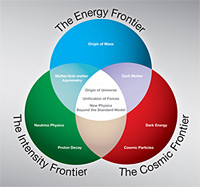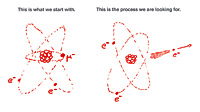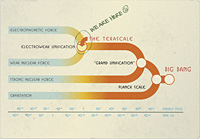Why muons at the Intensity Frontier?
Particle physics has been very successful in creating the Standard Model, a theoretical framework that describes all known particles and their interactions. But this model appears to be incomplete and breaks down at high energies such as those that existed shortly after the Big Bang. This suggests new particles and interactions exist beyond what is accounted for in the Standard Model.
One mystery in this catalogue of particles and forces is that in the framework of the Standard Model, particles fit neatly into three categories with similar properties, yet very different masses. The heaviest of these mass states have not existed naturally since shortly after the Big Bang. Physicists theorize that a rare, undiscovered combination of forces interacting on particles could cause this mass variation. This unification of all known forces — the gravitational, electromagnetic, weak and strong forces - could hold sway over our world.
Mu2e will help test whether what is at work is a merging of all forces into one "grand unification" of forces that existed shortly after the Big Bang when the universe was full of heavy particles. A muon that does not follow the traditional weak-force decay pattern into a lighter electron and two neutrinos, but converts wholly into an electron would signal the existence of new particles or new forces - particles or forces beyond those included in the Standard Model. These new particles or forces would play a role in the unification process.
For efficiency reasons, physicists chose to study the conversion of a muon, the second heaviest building block of matter, and not the heavier tau particle's conversion. Muons live longer before they decay into lighter particles and are easier to produce in large quantities.
Seeing muon-to-electron conversion will be more difficult than finding a needle in a haystack and will require patience and vast quantities of muons.
In fact, theorists predict that this type of conversion happens so rarely that observing it would equate to finding one penny with a unique scratch on Abe Lincoln's head. That penny would be hidden in one of 234 piles of pristine pennies with each pile amounting to the 2010 U.S. budget of $3.55 trillion.
To increase the probability of seeing this rare subatomic process, physicists will generate huge numbers of muons by colliding a proton beam with a target.
During the experiment's initial two-year running period, it will produce about one quintillion muons, which is roughly the number of grains of sand on Earth's beaches.
This research strategy of producing vast quantities, or intense amounts, of particles rather than focusing on accelerating them to the highest energy marks studies on the Intensity Frontier. Particle physics research is divided into three broad approaches called frontiers. Studies on the Intensity Frontier require extreme machines, such as multi-megawatt proton accelerators that produce high-intensity beams, which generate large numbers of particles.
A second-phase, upgraded Mu2e experiment could utilize a proposed high-intensity upgrade to Fermilab's proton accelerator, that would increase the production of muons by one to two orders of magnitude.


 European Project
European Project





